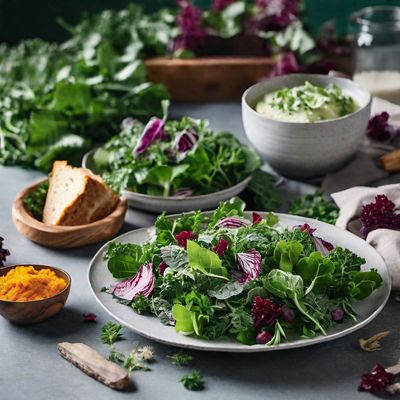
Ingredient
Roselle leaves
The Vibrant Tang of Roselle Leaves
Roselle leaves are known for their vibrant red color and tangy flavor. They have a slightly sour taste with hints of cranberry and lemon. The leaves are often used to make herbal teas, jams, jellies, and sauces. They can also be used as a garnish or added to salads for a pop of color and tanginess.
Origins and history
Roselle leaves have a long history of culinary and medicinal use. They are native to West Africa and have been cultivated for centuries in tropical and subtropical regions. In many cultures, roselle leaves are used to make refreshing beverages, such as hibiscus tea, which is known for its cooling properties. They are also used in traditional medicine for their potential health benefits, including their antioxidant and anti-inflammatory properties.
Nutritional information
Roselle leaves are low in calories and rich in vitamin C, antioxidants, and minerals like iron and calcium. They also contain compounds that may help lower blood pressure and cholesterol levels.
Allergens
There are no known allergens associated with roselle leaves.
How to select
When selecting roselle leaves, look for fresh, vibrant leaves that are free from blemishes or signs of wilting. The leaves should have a deep red color and a slightly crisp texture. Avoid leaves that are yellowing or have brown spots, as they may be past their prime.
Storage recommendations
To store roselle leaves, place them in a plastic bag or airtight container and refrigerate. They can stay fresh for up to a week. Alternatively, you can freeze the leaves for longer storage. To do this, blanch the leaves in boiling water for a few seconds, then transfer them to an ice bath to cool. Once cooled, drain and pack them in freezer-safe bags or containers.
How to produce
Roselle leaves can be easily grown in warm climates with well-drained soil and plenty of sunlight. They can be started from seeds or propagated from cuttings. Regular watering and fertilization will help promote healthy growth and abundant leaf production.
Preparation tips
Roselle leaves can be used in a variety of ways. They can be brewed into a refreshing herbal tea by steeping them in hot water for a few minutes. The tea can be enjoyed hot or cold, and sweetened with honey or sugar if desired. Roselle leaves can also be used to make jams, jellies, and sauces, adding a tangy twist to your recipes. Additionally, they can be used as a garnish or added to salads for a pop of color and flavor.
Culinary uses
Roselle leaves are commonly used in cuisines from around the world. They are a key ingredient in hibiscus tea, which is popular in many countries, including Mexico, Egypt, Sudan, and Thailand. They are also used in traditional dishes and beverages in West African, Caribbean, and Indian cuisines.
Availability
Mexico, Egypt, Sudan, Thailand, West Africa, Caribbean, India
More ingredients from this category
Recipes using Roselle leaves » Browse all

Dominican-style Pickled Sorrel Leaves
Tropical Tang: Dominican Pickled Sorrel Leaves

Awadhi-style Salmon with Sorrel Sauce
Nawabi Salmon Delight: A Fusion of Awadhi and French Flavors

Sauerampfersuppe (German Sorrel Soup)
Tangy Delight: German Sorrel Soup

Shchavel Borsch
Savory Sorrel Borsch: A Russian Delight

Red Sorrel Leaves Chutney
Tangy Twist Chutney: A Burst of Flavor with Red Sorrel Leaves

Creamy Sorrel Soup
Sorrel Delight: A Creamy Twist on Polish Cuisine

New Nordic Caesar Salad
Nordic Twist on a Classic: New Nordic Caesar Salad

Jamaican Shukto
Caribbean Delight: Jamaican Shukto - A Fusion of Flavors

Valencian Sauerampfersuppe
Tangy Valencian Sorrel Soup: A Burst of Mediterranean Flavors

Saumon à l'oseille with Lemon Butter Sauce
Luscious Lemon Butter Salmon with a Tangy Twist

Nouvelle Shchavel Borsch
Elevated Shchavel Borsch: A Modern Twist on a Russian Classic

Red Sorrel Leaves Chutney with a Eurasian Twist
Tangy and Spicy Eurasian Red Sorrel Leaves Chutney
